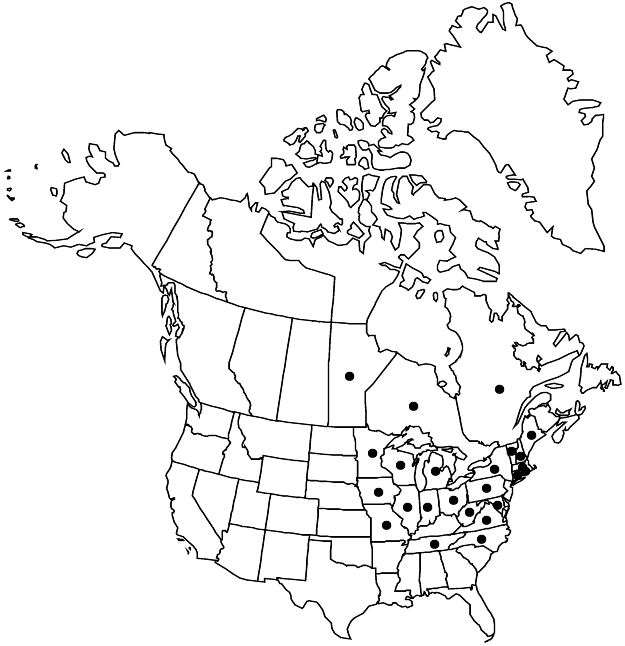Crataegus succulenta
Handbuch 2: 78. 1831.
Shrubs or trees, 40–80 dm. Stems: older trunks usually bearing compound thorns; twigs: new growth reddish green, glabrous, 1-year old dark, shiny redbrown, 2–3-years old becoming dark gray, older ± paler gray; thorns on twigs numerous, usually recurved, shiny, 1-year old dark blackish brown, stout, 3–6 (–8) cm. Leaves: petiole 1–2 cm, narrowly winged distally, glabrous, eglandular; blade rhombic-elliptic to broadly rhombic-ovate or elliptic, 4–7 cm widest near middle, subcoriaceous mature (then often blue-green), base cuneate (constricted), lobes 3–5 per side, obscure to well-marked, sinuses shallow, lobe apex usually subacute to obtuse, margins serrate except proximally, veins 6–8 per side, impressed, apex acute to subacute, rarely obtuse, abaxial surface glabrous, adaxial scabrate-pubescent young. Inflorescences 15–30-flowered; branches pubescent or glabrous; bracteoles linear, 1.7 cm, margins glandular. Flowers 12–17 mm diam.; hypanthium glabrous or pubescent; sepals narrowly triangular, 4–6 mm, margins glandular-serrate to glandular-laciniate, abaxially glabrous, adaxial pubescence not recorded; stamens 20, anthers usually red or pink, rarely white, 0.5–0.7 mm; styles 2 or 3. Pomes bright or deep red, lustrous, suborbicular, (4–) 7–10 (–14) mm diam., glabrous, rarely pubescent; flesh mealy or succulent mature; sepals spreading-reflexed; pyrenes 2 or 3, sides pitted. 2n = 51.
Distribution

Man., Ont., Que., Conn., Ill., Ind., Iowa, Maine, Mass., Md., Mich., Minn., Mo., N.C., N.H., N.Y., Ohio, Pa., R.I., Tenn., Va., Vt., W.Va., Wis.
Discussion
Varieties 5 (5 in the flora).
Crataegus succulenta ranges through the southern Great Lakes area to the middle St. Lawrence and southern New England, to Minnesota, to Iowa, Missouri (very rare), and Ohio, the Appalachians to North Carolina. An outlier has recently been recognized in Manitoba.
The dark twig colors of Crataegus succulenta are dramatic in winter and the coral red expanding bud scales are conspicuous in spring, more so than in most other species of hawthorn except C. macracantha. In summer, its commonly bluish green leaves, eglandular petioles, and impressed venation combine with thorn and twig characteristics to make this and C. macracantha usually instantly recognizable.
Crataegus succulenta often forms suckering thickets in the north.
Selected References
None.
Lower Taxa
Key
| 1 | Leaf blades proportionately narrow (1.6–2:1), elliptic to rhombic-elliptic or narrowly ovate | Crataegus succulenta var. neofluvialis |
| 1 | Leaf blades proportionately wide (1.3–1.6:1), ovate to broadly rhombic-ovate or broadly elliptic | > 2 |
| 2 | Pomes 4–6 mm diam. | Crataegus succulenta var. pisifera |
| 2 | Pomes 7–14 mm diam | > 3 |
| 3 | Pomes 12–14 mm diam. | Crataegus succulenta var. gemmosa |
| 3 | Pomes 7–10 mm diam | > 4 |
| 4 | Anthers red or pink. | Crataegus succulenta var. succulenta |
| 4 | Anthers white. | Crataegus succulenta var. michiganensis |
"widest" is not a number."adnate" is not a number."dm" is not declared as a valid unit of measurement for this property.